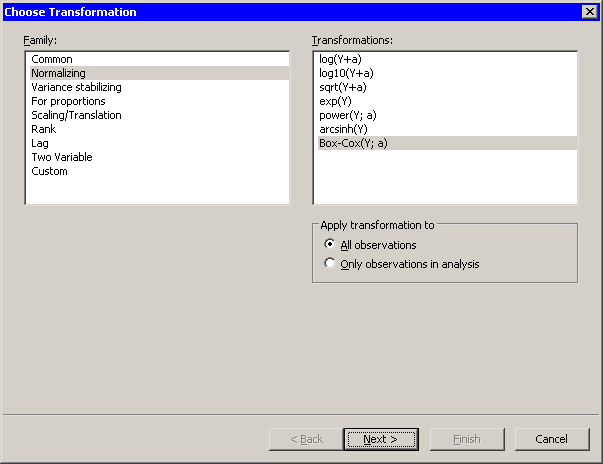| Variable Transformations |
Normalizing Transformations
Figure 32.12 shows the transformations that are available when you select Normalizing from the Family list. These transformations are often used to improve the normality of a variable. Equations for these transformations are given in Table 32.2.
 |
Figure 32.12: Normalizing Transformations
Table 32.2: Description of Normalizing Transformations
| Default | Name of | ||
|---|---|---|---|
| Transformation | Parameter | New Variable | Equation |
| log(Y+a) | Log_Y | ||
| log10(Y+a) | Log10_Y | ||
| sqrt(Y+a) | Sqrt_Y | ||
| exp(Y) | Exp_Y | ||
| power(Y;a) | Pow_Y | ||
| arcsinh(Y) | Arcsinh_Y | ||
| Box-Cox(Y;a) | MLE | BC_Y | See text. |
The Box-Cox transformation (Box and Cox 1964) is a one-parameter family of power transformations that includes the logarithmic transformation as a limiting case. For ![]() ,
,
You can specify the parameter, ![]() , for the Box-Cox transformation, but typically you choose a value for
, for the Box-Cox transformation, but typically you choose a value for ![]() that maximizes (or nearly maximizes) a log-likelihood function.
that maximizes (or nearly maximizes) a log-likelihood function.
SAS/IML Studio plots the log-likelihood function versus the parameter, as shown in Figure 32.8. An inset gives the lower and upper 95% confidence limits for the maximum log-likelihood estimate, the MLE estimate, and a convenient estimate. A convenient estimate is a fraction with a small denominator (such as an integer, a half integer, or an integer multiple of ![]() or
or ![]() ) that is within the 95% confidence limits about the MLE. Although the value of the parameter is not bounded, SAS/IML Studio graphs the log-likelihood function restricted to the interval
) that is within the 95% confidence limits about the MLE. Although the value of the parameter is not bounded, SAS/IML Studio graphs the log-likelihood function restricted to the interval ![]() .
.
A dialog box (Figure 32.9) also appears that prompts you to enter the parameter value to use for the Box-Cox transformation.
The log-likelihood function for the Box-Cox transformation is defined as follows. Write the normalized Box-Cox transformation, ![]() , as
, as
Copyright © 2009 by SAS Institute Inc., Cary, NC, USA. All rights reserved.

